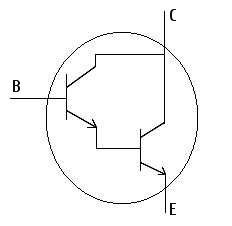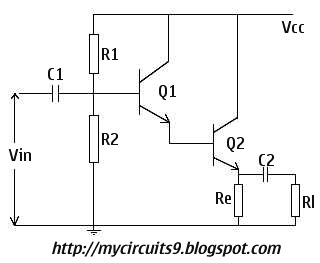INTRODUCTION TO DARLINGTON PAIR
In practice, the two transistors are put inside a single package and three terminals E, B and C are brought out as shown in figure.

This three terminal device is known as darlington pair. It acts like a single transistor that has high current gain and high input impedence.
DARLINGTON AMPLIFIER
Darlington amplifier with voltage divider bias is shown in figure. 
In this circuit the output of one amplifier is coupled into the input of the next one by directly joining emitter of one transistor to the base of Other. Obviously, the emitter current of the first transistor becames the base current for the second transistor.
The biasing analysis is similar to that of RC coupled Amplifier except that two Vbe drops are to be considered.
ADVANTAGES OF DARLINGTON AMPLIFIER
- It uses very few components and can be readily formed from two adjacent transistors in an IC.
- It provides excellent Characteristics of high input impedence with low output impedence and high current gain, all desirable Characteristics for a current gain amplifier.
APPLICATIONS OF DARLINGTON AMPLIFIER
It has enormous impedence transformation capability. Hence it is used as high gain operational amplifier which depends on very high input impedence for its operation as an integrator or summing amplifier in analogue applications. SOME DARLINGTON PAIR CIRCUITS
Water Tank Overflow alarm circuit
Rain Detector and Alarm Circuit
Comments
Post a Comment